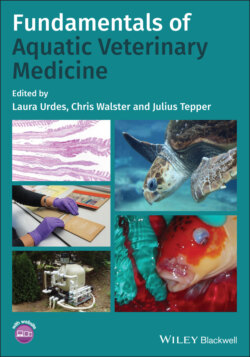Читать книгу Fundamentals of Aquatic Veterinary Medicine - Группа авторов - Страница 40
1.3.2.13 Greenhouse Gases and Climate Change
ОглавлениеElevation of carbon dioxide in the atmosphere leads to acidification of our water. This change affects all aquatic life. Millions of dollars are lost each year on decreased growth and increased mortality due to large fluctuations in the pH and temperatures of the water. Elevation in the CO2 levels of the atmosphere push the chemical reaction:
to move more toward a disassociation of water molecules and increase the HCO3–. In the ocean, this fluctuation is well buffered by salt water, but in coastal areas and rivers the addition of runoff increases the nitrogen, carbon and Ca2+, creating large fluctuations in the pH. Climate change has resulted in an increase of the ocean temperatures, changes in mixing and increased intensity of storms globally. These changes, together with large fluctuations in pH, result in large hypoxic zones and the inability of fish to acclimate to them.
Fish in estuaries and coastal areas are affected the most by acidification due to the increased fluctuation of the pH. This fluctuation is exaggerated by nutrient runoff, coastal upwelling, and atmospheric pollution. Fish have been shown to be able to regulate their pH within days, but they rely on the ability to move the CO2 into the lower partial pressure of carbon dioxide (pCO2) of the aquatic environment. As atmospheric CO2 increases, fish can compensate metabolically and regulate their pH but still show elevated levels of the CO2 in their extracellular fluids. Studies have shown that this elevated level of CO2 can cause problems with osmoregulation. In addition, studies have shown this increased level of CO2 can result in increased otolith size in clownfish, Atlantic cod and pollock (Heuer and Grosell, 2014).
The increased CO2 in the plasma has been shown to affect the metabolic rate and the formation of CaCO3+. This occurs when HCO3– is secreted into the intestinal lumen. This secretion stimulates the secretion of CO2. This combination precipitates the Ca2+ from the seawater that has been ingested. These then combine to form CaCO3+. The higher PCO2 in the plasma has been proven to increase these secretions in midshipmen and toadfish. CaCO3+ is important for osmoregulation in fish by influencing the osmotic pressure in the luminal cavity. Changes in the amount of CaCO3+ has the potential to decrease the osmotic balance (Heuer and Grosell, 2014).
Elevations in atmospheric CO2 have been shown to decrease calcification rates in the carbonate equation:
Decreases in calcification rates affect coral reefs, planktonic microalgae, coccolithophores, phytoplankton, and all shellfish. Coral reef growth has been shown to decline due to the decrease of calcification, with a predicted decrease of 21–40% over the period of 1880–2065 (Turley et al., 2006). This decline is also dependent on the temperature of the water and other available nutrients. Oysters and abalone have been the focus of many studies in regards to acidification. These organisms have been shown to have a decreased rate of survival at the larval stage due to lack of calcification of the shell and decreased ability to ingest nutrients. The shell of mollusks is produced throughout all its life stages. During the larval stages, the shell is made from deposition of amorphous calcium carbonate, which then forms into a crystalline aragonite. Both these stages of shell development are more soluble in a low pH. Studies have shown that certain levels of pH will cause holes to form in the shells (Wessel et al., 2018).
Acidification of our oceans has a great effect on the ecosystem of the ocean. It is leading to changes in the phytoplankton that are available for ingestion by fish and cultivation. It is predicted to decrease the available fish population of our reefs, which will damage the animal protein consumption of many developing nations. The high fluctuations of pH in the estuaries and coastal areas have the potential to greatly affect fisheries. Mitigation of these fluctuations should include consistent monitoring of the water to enable fisheries to add buffering if necessary (Clements and Chopin, 2017). Options for buffering may include:
Crushed shell hash in the sediment
Sodium bicarbonate
Movement of fish pends away from river mouths.
Further mitigation strategies should include breeding plants and animals that have a high tolerance for low pH. Integration of a multitrophic aquaculture system can help to mitigate pH fluctuations and other stress caused by run‐off and increased population. An integrated system should include three levels of nutrient absorption (Clements and Chopin, 2017):
Shell fish: small organic particle suspension extractive.
Seaweed: dissolved nutrients suspension extractive.
Invertebrates: large organic particle deposit extractive.
While acidification of natural aquasystems can only be mitigated by global reduction of atmospheric carbon dioxide, further research is necessary to fully understand the impacts of global climate change and the acidification of our oceans.
